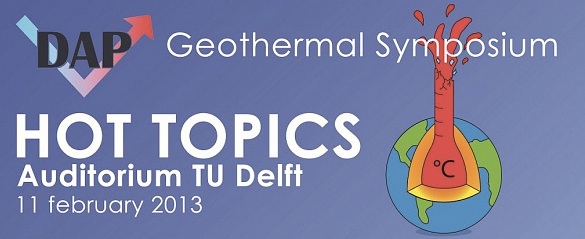Deep geothermal wells have a large heating potential for the Netherlands, according to experts at DAP’s “Hot Topics” symposium on 11 February. But nature is full of surprises and investors are cautious.
Over 200 people attended the third symposium organized by students from the Delft geothermal project (DAP) including students, employees, experts from other universities, research institutions and field specialists. In two sessions with lectures they shared ideas and experiences, mainly on deep geothermal energy for heating purposes.
The experiences just across the border in Lower Saxony, Germany are of interest, since the geology is very similar. Expert Robert Schöner (University of Erlangen) told that no less than 2,000 geothermal drillings were registered in the region. However, no geothermal site is in production so far. This is strange since temperature and reservoir quality data suggest that harvesting of geothermal heat should be feasible. What’s holding back progress, it seems, is lack of detailed geological data, especially on the quality, the permeability and thickness of groundwater reservoirs (called aquifers). “Nature is full of surprises”, said Schöner while showing a 3D underground map full of irregular dots indicating separate aquifers. And even when a flow between injection and production has been established, pipes can clog up as a consequence of salt cementation within the casing. The underground water contains high concentrations of salt and the water here in the Netherlands is similar.
On the other hand, if a geothermal system starts clogging up, or temperature drops, there are experts you can call. Roger Henneberger, for example, who works for GeothermEx, a firm that advises and consults on hundreds of geothermal resources all over the world. GeothermEx has recently been acquired by Schlumberger. Henneberger stressed the importance of injection of the pumped-up water, which may contain arsenic, bromium and mercury as well as hydrocarbons. Not something you’d like to see dumped into a river. But even when the geothermal well is a closed system, surprises do happen. To solve these, Henneberger told his audience, you’ve got to understand the reservoir, improve it if possible, design and locate injection wells and, above all, do not overexploit the resource.
In the Netherlands, a small number of commercial gardeners have taken up geothermal heating for their glass houses. With a failure rate of 10 to 30%, geothermal projects have been luckier than oil and gas explorations, which typically fail in nearly half of the drillings. Experts think that the geothermal potential in the Netherlands has hardly been tapped.
A fresh approach came from Floris Veeger MSc. who won the UfD Geo Energy Master award 2012 for his study of using gas and oil drill holes for geothermal projects. He noticed that not only do areas of interest for geothermal coincide with oil and gas drillings, but they’re often also on the same depth (2000 to 2500 meters). He found that of the over 2500 drill holes in the Netherlands, some 700 can in principle be used for winning hot water. “Thirteen of these have been abandoned, so they can be used immediately”, said Veeger.
Veeger also told that geothermal production sometimes goes hand in hand with gas production. Green Well Westland for instance produces just as much cubic meters of gas as of hot salt water. And the heat from the gas production in Monster (near The Hague) is in use for heating the local swimming pool.
Another benefit of using existing drill holes is that the geology of the subsurface is well known. Veeger, who works for Hydreco, wants to develop a depleted gas drilling site at Middenmeer (North of Amsterdam) as a pilot project for geothermal production. However, a revival of gas production has delayed the conversion.
Veeger told how he brought people from small geothermal companies together with oil and gas industry members to explore common interests. In principle exploration costs could be split and production life could be extended by setting up cooperation. However, Veeger observed, there was too little incentive for the oil and gas industry to do so, plus they had their reservations in setting up shop with small start-ups for large sums of money (a drill costs 3 to 6 million euros) and long periods of time.
http://www.delftaardwarmteproject.nl/symposium



Comments are closed.